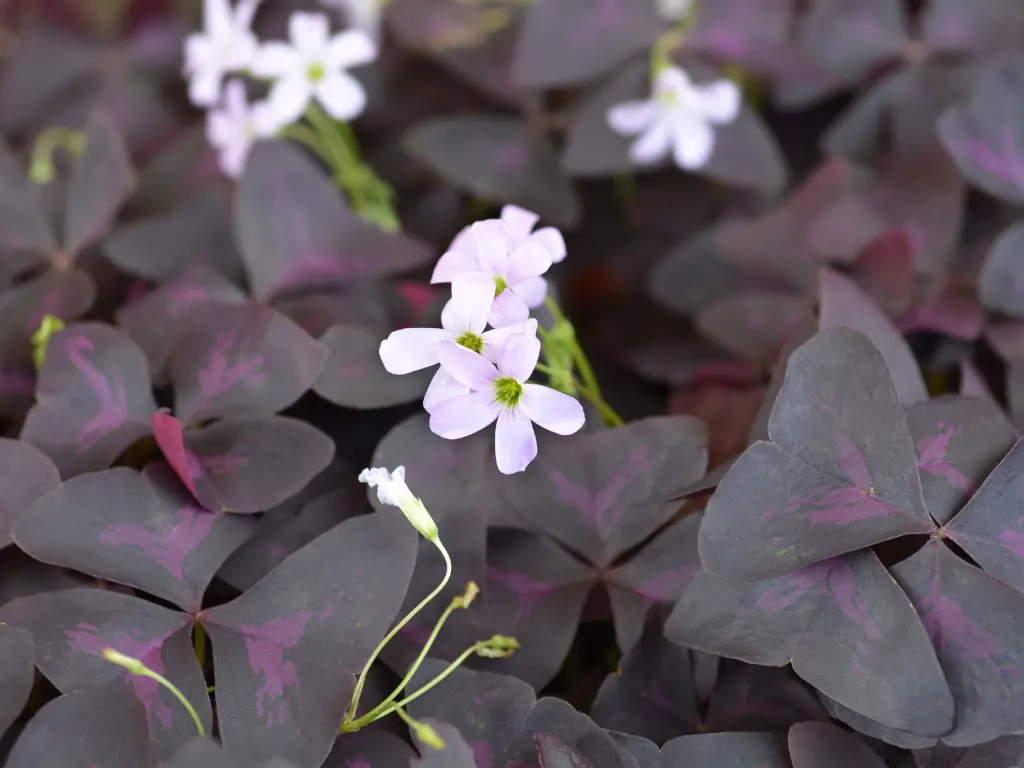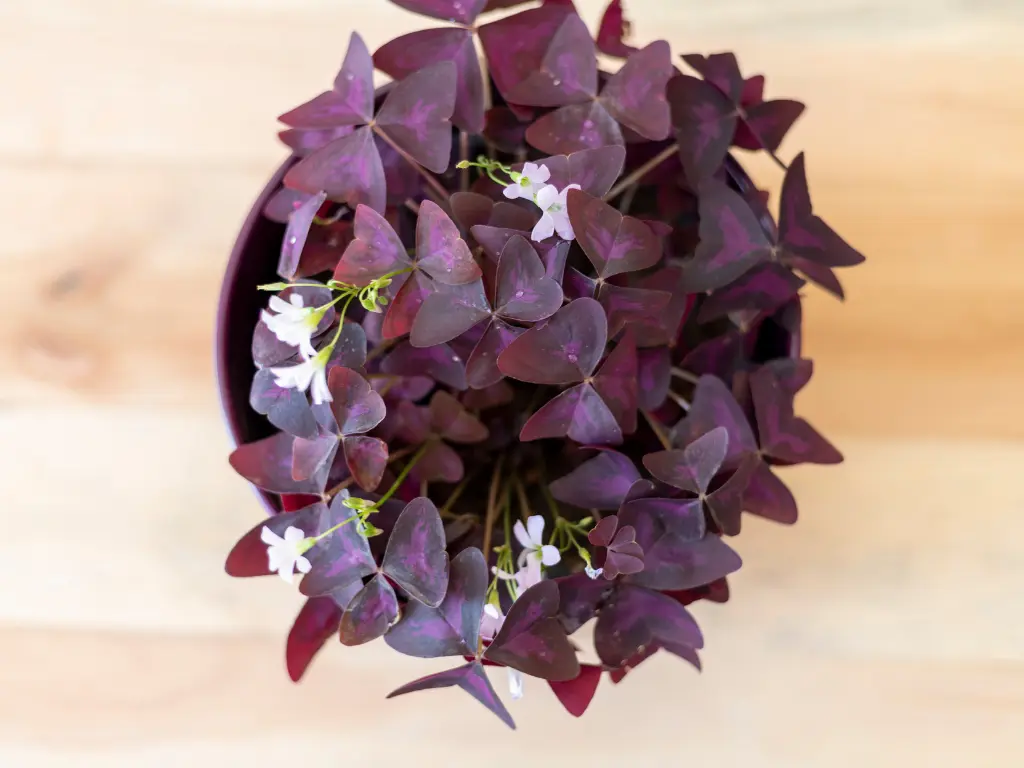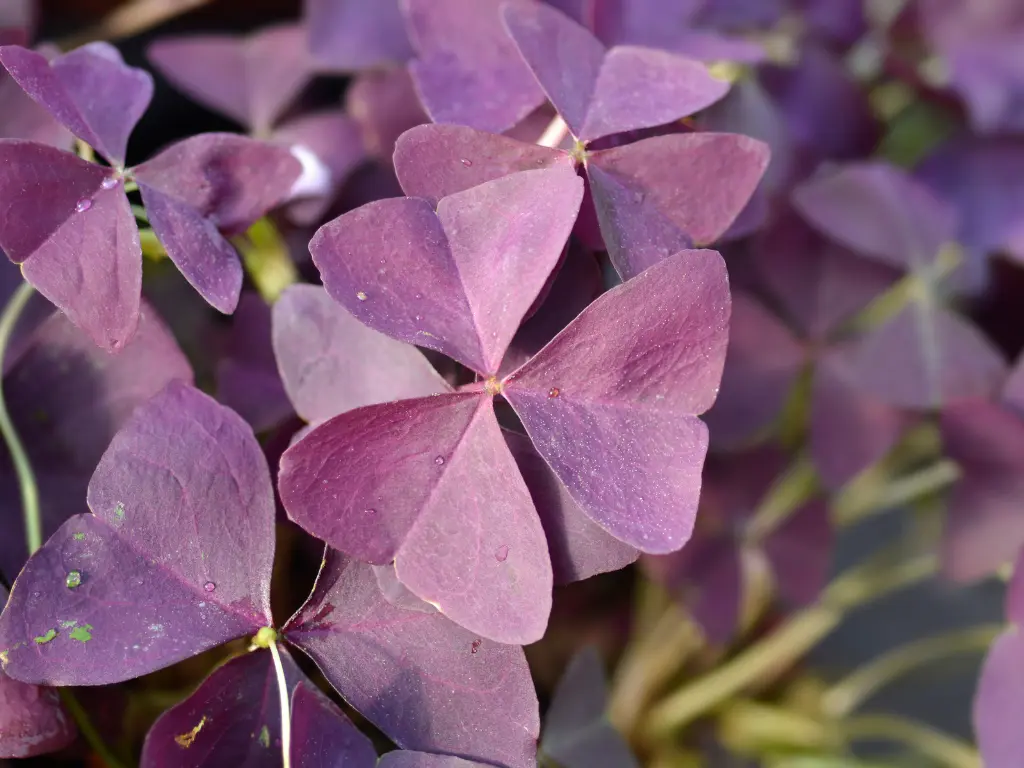Shamrock plants (Oxalis triangularis) are attractive houseplants valued for their unique triangular leaves and delicate blooms. Often called false shamrock or purple shamrock, these plants fold their leaves up at night and reopen with morning light, resembling fluttering butterflies. When grown indoors with proper care, they add a touch of elegance and color to any space.
In this post, I’ll share practical tips, real gardener experiences, and solutions to keep your purple shamrock (Oxalis triangularis) thriving indoors all year round.
What is Oxalis Triangularis?

Oxalis triangularis, also known as false shamrock or purple shamrock, is a bulbous perennial native to Brazil. Belonging to the Oxalidaceae family, this plant is famous for its striking deep purple leaves shaped like triangles or butterflies.
One of the coolest things about Oxalis triangularis is how its leaves move. In the morning, they open up to greet the sun, and in the evening, they fold down like sleeping butterflies. This photophilic movement makes it feel like your plant is alive and interacting with you every day.
Unique Features
Here are a few reasons why so many indoor gardeners adore this plant:
-
Its vibrant purple color adds a pop of personality to any shelf or windowsill.
-
Tiny white or pale pink flowers bloom throughout the year, making it even more charming.
-
Its compact size makes it perfect for apartments, dorm rooms, or small home offices.
-
It grows from bulbs, so you can propagate and share it easily with friends.
Honestly, if you love plants that feel a bit magical, purple shamrock is one you’ll want in your collection.
Oxalis triangularis Indoor Care

Light
Shamrock plants thrive in bright, indirect light. Place them near a south- or east-facing window where they can receive at least four hours of filtered sunlight daily. While they tolerate some direct sun, exposure to harsh afternoon rays can scorch the foliage, causing brown leaf tips. If natural light is insufficient, consider using a grow light to provide adequate illumination, especially during darker winter months.
If you notice its stems getting long and leggy, that’s a sign it’s stretching towards the light and needs a brighter spot.
I keep mine on a bookshelf near a window with sheer curtains, and it stays perfectly happy.
Soil
Plant a shamrock in a well-draining potting mix to protect roots from rot. A standard indoor potting soil combined with perlite or coarse sand improves aeration and drainage. Avoid heavy, compacted soils that retain excess moisture. Adding a small amount of compost or worm castings can enhance soil fertility and promote healthy growth.
Water
Water your shamrock plant whenever the top inch of soil feels dry. Insert your finger into the soil to check moisture levels before watering. Water thoroughly until it drains out of the bottom, and discard excess water to prevent soggy conditions. During the plant’s dormant period in summer, reduce watering frequency to once every two to three weeks, allowing the soil to remain barely moist but not completely dry or wet.
Temperature and Humidity
Maintain indoor temperatures between 60–75°F (15–24°C) for optimal growth. Shamrock plants can tolerate cooler nighttime temperatures down to 50°F (10°C) but are sensitive to drafts and sudden temperature changes. Keep them away from air conditioning vents, heaters, and frequently opened doors.
Average indoor humidity is generally sufficient, but the plant will benefit from moderate humidity levels (40–60%). If the air is too dry, especially in winter, consider placing the pot on a humidity tray or using a room humidifier to maintain foliage health.
Fertilizer
Feed your shamrock plant with a balanced liquid houseplant fertilizer every two to three weeks during its active growing season (fall to spring). Dilute to half the recommended strength to avoid fertilizer burn. Alternatively, use a slow-release fertilizer granule at the beginning of the growing season for consistent nutrition. Avoid fertilizing during dormancy, as the plant is not actively growing.
Potting and Repotting
Shamrock plants prefer being slightly root-bound, which encourages blooming. Repotting every two to three years is ideal. Choose a pot that is only slightly larger than the previous container, and ensure it has drainage holes. Terracotta pots are excellent because they allow moisture to evaporate through the walls, reducing the risk of root rot.
When repotting:
-
Gently remove the plant from its pot.
-
Shake off excess soil and inspect the bulbs for signs of rot or overcrowding.
-
Replant in fresh potting mix at the same depth.
-
Water lightly and place in bright, indirect light.
Care Tips During Dormancy
Shamrock plants naturally go dormant during the summer months or in response to heat stress. Signs of dormancy include yellowing and dying leaves. When this happens:
-
Reduce watering to prevent bulb rot.
-
Stop fertilizing.
-
Allow the plant to rest in a cool, dry place for several weeks to months until new growth appears.
Once new shoots emerge, resume normal care by watering regularly and feeding with diluted fertilizer.
Think of dormancy as your plant’s nap time – it comes back stronger after its rest.
Propagation

Shamrock plants are propagated using their bulbs (tubers), which multiply underground over time. The best time to propagate is in early spring before active growth or right after dormancy ends when bulbs are ready to grow again.
How to Propagate by Bulbs
-
Carefully remove the plant from its pot.
-
Gently separate the bulbs from the root cluster.
-
Plant bulbs 1 to 2 inches deep, with the narrow end facing upward.
-
Space each bulb 3 to 4 inches apart.
-
Water lightly after planting and keep the soil slightly moist.
New growth typically appears within three to four weeks if provided with warm temperatures and bright light.
Common Problems and Solutions
Why is My Oxalis Triangularis Drooping?
This is probably the most common question gardeners ask about purple shamrock. Often, overwatering is the main reason, as soggy soil causes roots to rot and leaves to collapse. Underwatering, especially in hot weather, can also make the plant droop because it’s not getting enough moisture.
Another normal reason is its natural dormancy cycle. When entering dormancy, the leaves will die back temporarily before regrowing. Lastly, sudden temperature changes or drafts can shock the plant and cause drooping.
Always check soil moisture before worrying. If it’s too wet, let it dry out; if it’s too dry, water thoroughly. If watering seems fine and the plant looks like it’s shutting down, it’s probably just going dormant.
Yellowing Leaves Causes
Yellowing leaves can happen for a few reasons. Too much direct sunlight can burn the foliage, while overwatering can damage roots. Sometimes, older leaves simply yellow and die off as part of the plant’s natural cycle. If only a few leaves are affected, there’s usually nothing to worry about.
Pests and Diseases to Watch Out For
Oxalis triangularis is generally pest-free, but sometimes spider mites (tiny webs under leaves) or aphids (sticky residue, deformed growth) can appear. Treat them with insecticidal soap or neem oil spray if needed.
Keeping your plant healthy and avoiding stress is the best prevention against pests and diseases.
Frequently Asked Questions
How often should I water my indoor shamrock plant?
Water whenever the top inch of soil feels dry, typically once every 7–10 days depending on indoor conditions.
Why is my shamrock plant losing leaves?
Leaf loss can indicate dormancy, overwatering, or insufficient light. Assess the care routine and adjust accordingly.
Does a shamrock need pruning?
Regular pruning is not necessary, but removing spent flowers and yellowing leaves improves appearance and encourages healthy growth.
Can I grow shamrocks under artificial light?
Yes. Shamrock plants respond well to LED grow lights placed about 6–12 inches above the foliage for 10–12 hours daily.
Caring for your Oxalis triangularis indoors is simpler than you think. With the right care, your shamrock plant will thrive indoors, delighting you with its striking foliage and delicate blooms season after season. If you’ve tried growing Oxalis triangularis, I’d love to hear your stories. Share your purple shamrock experiences in the comments below or tag me on Instagram with your thriving plant photos.
